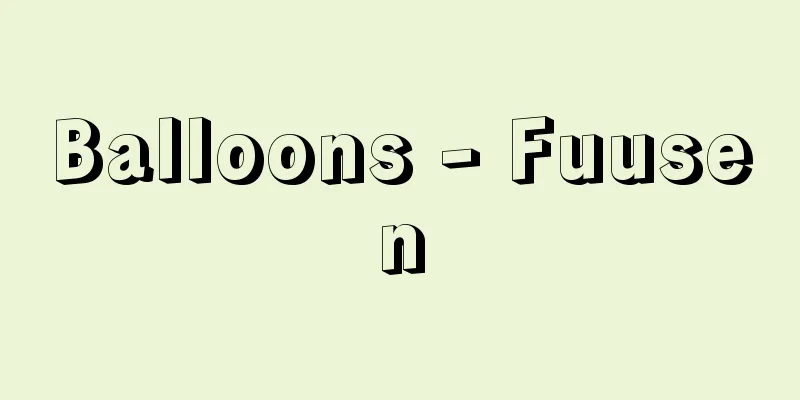Balloons - Fuusen

|
A toy (gangu) in which air or hydrogen gas is filled inside a ball made of paper, rubber, vinyl, etc., and which is played with by hitting it with the hand or throwing it into the air. Rubber balloons are filled with hydrogen gas and sent flying into the air. In Japan, they are said to have been first sold by a Chinese merchant in Yokohama in 1868 (Meiji 1). They were also sold in Kobe in the same year under the name "rubber squid" (ika is the Kansai name for kite). In Osaka, a British medical practitioner named Hartley also made and sold them, making a huge profit. The first domestically produced rubber balloons were made in 1875 (Meiji 8) by Ichikawa Morisaburo, a physics teacher at the former Kaisei School in Tokyo, who filled small red rubber balls with hydrogen gas and made them fly up. The following year they were sold as children's toys at festival stalls and became popular. At the time they were also called tamadako (ball kites), puffed balls, or konpei (compei). Around 1887, "rubber maribue" (rubber ball flutes), made by attaching a bamboo flute to a rubber balloon, appeared. With this, air is blown into the tube of the flute to inflate a rubber balloon, and when the mouth is released and the air is released, the set flute continues to sound. Because the tube is decorated with a colored chicken feather, it is also called a "hair flute," and even today they can be seen at festival stalls and small toy stores. At the end of the Meiji period, a method of coloring pictures and letters on rubber was invented. During the Taisho period, the First World War brought about a boom and production increased, with 500,000 gross being exported in 1917 (Taisho 6). Currently, character items featuring the main characters of television programs and manga are popular, and they are also widely used at sports festivals and product sales services. Paper balloons are also called kami temari (paper handballs) or kuki dama (air balls). They are balls made by cutting colored paper into the shape of flower petals and gluing them together. They are played with by blowing air into them through a small hole in the mouth of the balloon to inflate them into a round shape and then pushing them up into the air. They became popular around 1891 (Meiji 24), and later ones with bells inside were also made. In addition to being used as children's toys, they are used for sports days and for interior decoration. [Ryosuke Saito] Source: Shogakukan Encyclopedia Nipponica About Encyclopedia Nipponica Information | Legend |
|
紙、ゴム、ビニル製などの球の中に空気または水素ガスを入れ、これを手でついたり、空中へ飛ばして遊ぶ玩具(がんぐ)。 ゴム風船は、水素ガスなどを詰めて空中に飛ばす。日本では、1868年(明治1)横浜で中国商人が売り出したのが最初といわれる。同年神戸でも「ゴムいか」(いかは凧(たこ)の関西での呼び名)の名で売られたという。大阪でもイギリス人の開業医ハルトリーが、やはりこれをつくって売り、大いに利を得たという。国産のゴム風船は、1875年(明治8)東京の旧開成学校の物理教師市川盛三郎が、赤ゴムの小球に水素ガスを満たして飛揚させたのが初めで、翌年から縁日の露店などで子供の玩具として売り出され流行した。当時は球凧(たまだこ)、ふくれ玉ともよばれ、あるいはコンペイともいった。87年ごろからゴム風船に竹笛をつけた「ゴム毬笛(まりぶえ)」が登場した。これは笛の管から息を吹き込んで、ゴム風船を膨らませてから口を離し、空気を排出させると、それにつれて仕掛けた笛が鳴り続ける。管には彩色したニワトリの羽根飾りがついているので「毛笛」ともいい、現在でも縁日の露店や小物玩具店などにみられる。明治末期には、ゴム地に絵や文字を彩色する方法も発明された。大正時代には第一次世界大戦の影響で好況を迎えて生産が増大し、1917年(大正6)には50万グロスも輸出した。現在はテレビ番組や漫画の主人公などを扱ったキャラクターものなどに人気があり、そのほかスポーツの祭典、商品の売り出しサービスなどにも利用され広く使われている。 紙風船は、紙手鞠(てまり)、空気玉ともいう。色紙を花びら形に切って張り合わせた球で、吹き口の小穴から息を吹き込んで丸く膨らませ、突き上げたりして遊ぶ。1891年(明治24)ごろから流行し、のちには鈴入りのものもつくられた。子供の遊び道具のほか、運動会や室内装飾などに利用される。 [斎藤良輔] 出典 小学館 日本大百科全書(ニッポニカ)日本大百科全書(ニッポニカ)について 情報 | 凡例 |
Recommend
Arvida (English spelling)
A city on the Saguenay River in southern Quebec, C...
Appendicitis - appendicitis
The end of the small intestine transitions into t...
minestrone
...The most well-known examples are the Parisien,...
Competitive contract
A contract is a contract in which many potential c...
Fresh-Looking Earth
...Since then, the combination of Itami scriptwri...
Alopecia areata - Alopecia areata
What kind of disease is it? (The cause is unknown...
Turnip rose - Turnip rose
…So, rather than sticking to the traditional syst...
Folk song - Ryo
One of the old names for Japanese folk songs. Sato...
Concephalus maculatus (English spelling)
…[Yamazaki Harane]. … *Some of the terminology th...
Terebra maculata (English spelling)
…[Tadashige Nabe]. . … *Some of the terminology t...
Ezomuukashiebi - Ezomuukashiebi
…Since the first species, Bathynella natus , was ...
rabbiteyeblueberry
...Three groups of blueberries are important in t...
Jones Act
The Philippine Autonomy Act was passed by the US C...
anthologia
…In the case of poetry, it is often translated as...
Helminth - Helminth
Also called worms, they are a collective term for...









